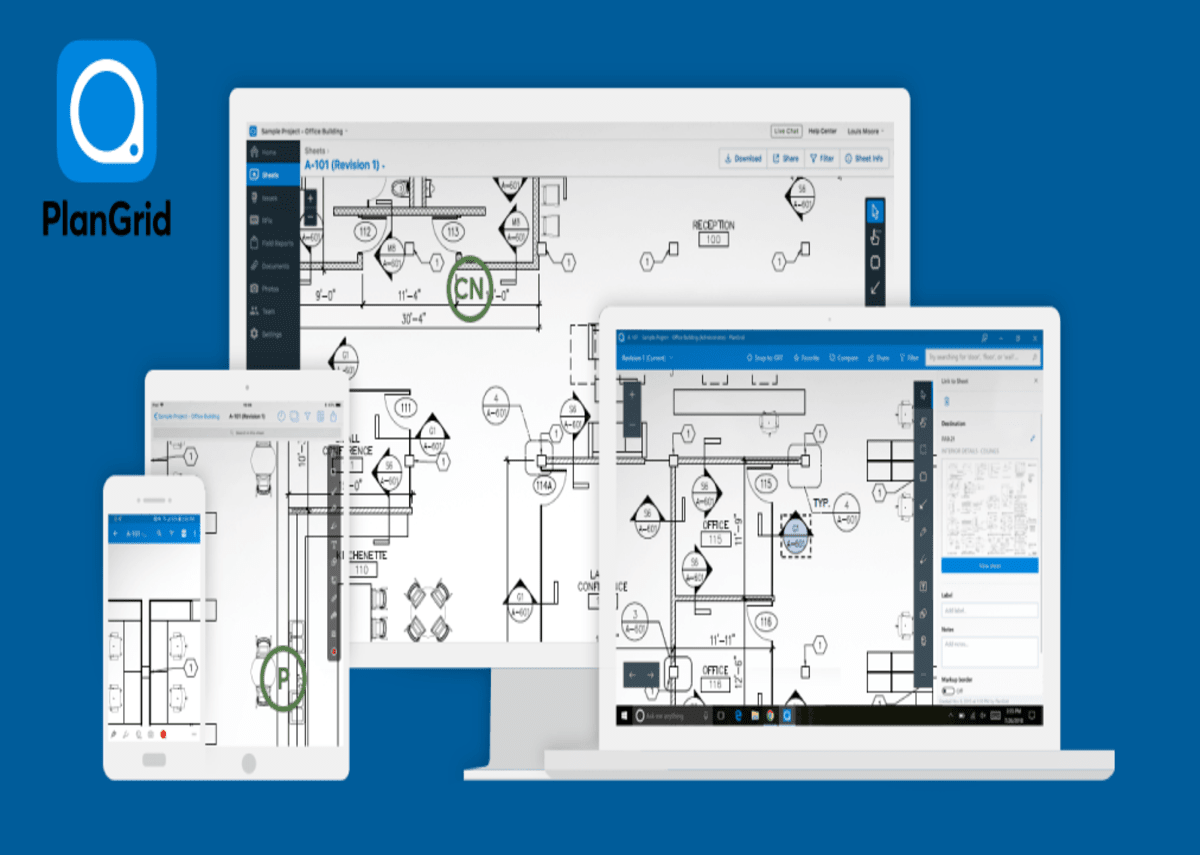The realm of construction management software is bustling with innovation and competition. PlanGrid has established itself as a formidable player, providing comprehensive solutions for construction RFI needs and project management. However, several other software giants are vying for the top spot, offering unique features and capabilities that challenge PlanGrid’s dominance. In this article, we explore the top competitors of PlanGrid and delve into the features that make each of them stand out in the crowded construction software market.
Table of Contents
Key Takeaways
- CoConstruct is a strong PlanGrid competitor, excelling in project management, budgeting, and client communication, streamlining the construction management process.
- Wrike expands the project management horizon with visual tools, resource tracking, and a high degree of customization, catering to diverse construction needs.
- Autodesk BIM 360 leads in construction coordination and issue resolution, leveraging data analytics and cloud support for enhanced project delivery.
- Procore focuses on construction-specific functionalities like submittal management and real-time data reporting, offering a tailored user experience.
- Emerging trends in construction management software highlight the growing adoption of AR/VR technologies and the demand for advanced productivity features.
CoConstruct: A Comprehensive Construction Management Contender

Streamlining Project Management
In the competitive landscape of construction management software, CoConstruct stands out by offering a suite of tools designed to streamline project management. By employing effective problem-solving techniques, CoConstruct helps maintain project momentum and minimize delays, which is crucial in a field where time is money.
Resource Management is a key aspect of streamlining project management. CoConstruct ensures that all parties have the necessary tools, equipment, and materials to complete their tasks efficiently. This coordination is vital for the smooth operation of overlapping projects.
Budget Management is another critical component. CoConstruct enables close monitoring of project budgets, tracking expenses, and ensuring adherence to financial constraints. This vigilance helps in identifying cost-saving opportunities without compromising on quality.
Here’s how CoConstruct compares to PlanGrid in key project management aspects:
- Customizable reports for tailored insights
- Real-time collaboration to keep all stakeholders informed
- Seamless data transfer within ecosystems for integrated project oversight
Budgeting and Cost Control
Effective budgeting and cost control are pivotal for maintaining the financial health of any construction project. CoConstruct excels in providing detailed cost analysis and budget management tools that cater to the needs of project managers, clients, and other stakeholders.
- Develop and manage project cost reports
- Evaluate actual vs. forecasted costs
- Provide detailed cost risk analysis
- Support earned value analysis
- Review and approve subcontractor invoices
CoConstruct’s platform simplifies the complex process of tracking expenses, ensuring that projects remain within financial constraints. It identifies cost-saving opportunities without compromising on quality, which is essential for successful project completion.
The software’s budget management capabilities allow for real-time monitoring of project budgets, offering insights into potential financial risks and mitigation strategies. This proactive approach to financial management ensures that all parties are equipped with the necessary information to make informed decisions.
Enhancing Communication and Collaboration
CoConstruct’s suite of communication tools is designed to enhance collaboration among all stakeholders in a construction project. Automating proposals and centralizing team collaboration are key features that streamline interactions and ensure that everyone is on the same page. With the ability to assign tasks and enable remote teams, CoConstruct supports a flexible work environment, allowing subject matter experts (SMEs) to engage from any location.
CoConstruct is a cloud-based construction management software that streamlines project execution and client communications.
Real-time insights into proposal progress and project dashboards facilitate proactive management and quick response times. This ensures that deadlines are met and that the quality of communication remains high throughout the project lifecycle.
- Automate your proposals
- Centralize team collaboration
- Assign tasks and enable remote teams
- See real-time insights
User Experience and Accessibility
In the competitive landscape of construction management software, user experience (UX) and accessibility are pivotal. CoConstruct ensures that its platform is not only powerful but also user-friendly, catering to the diverse needs of construction professionals. The software’s intuitive design minimizes the learning curve, allowing new users to quickly become proficient.
Ease of use is a critical factor that distinguishes CoConstruct from its competitors. The platform’s accessibility features are designed to accommodate users with varying levels of tech-savviness, ensuring that all team members can effectively collaborate regardless of their location or device.
CoConstruct’s commitment to UX and accessibility is evident in its continuous updates and feature enhancements, aimed at simplifying the complexities of construction management.
While PlanGrid has set a high standard in the industry, CoConstruct’s focus on user experience positions it as a formidable challenger. The software’s adaptability and approach to user-centric design are key to its growing popularity among construction firms.
Wrike: Beyond Basic Project Management

Visual Project Planning Tools
Wrike stands out in the construction management software market with its visual project planning tools. Builders can visualize projects in a way that enhances understanding and communication among team members. The platform allows for the creation of detailed project timelines, which can be easily adjusted as projects evolve.
- Interactive Gantt charts
- Kanban boards for task management
- Customizable workflow views
These features facilitate a more intuitive management experience, ensuring that all stakeholders have a clear view of the project’s progress and upcoming milestones. Wrike’s visual tools are designed to help teams stay on track and efficiently manage resources, which is crucial in the dynamic environment of construction projects.
Wrike’s visual project planning capabilities are not just about aesthetics; they’re about making complex project information accessible and actionable for everyone involved.
Resource Allocation and Progress Tracking
Wrike stands out in the realm of construction management software with its robust approach to resource allocation and progress tracking. The platform enables project managers to efficiently distribute tasks and monitor ongoing work, ensuring that resources are utilized to their fullest potential.
Resource Management:
- Coordinate with internal teams, subcontractors, and suppliers.
- Provide necessary tools, equipment, and materials for tasks.
- Monitor project budgets and track expenses.
Effective resource allocation is crucial for keeping projects on track and within budget. Wrike’s tools facilitate a seamless flow of information and resources, making it easier to identify and address potential bottlenecks before they impact the project timeline.
Budget Management:
- Identify cost-saving opportunities without compromising quality.
- Enforce quality control measures to maintain standards.
- Implement systematic reporting and updating of project status.
Customization and Scalability
In the realm of construction management software, customization is crucial to winning. While a knowledge library provides a solid foundation, the ability to tailor solutions to specific client needs sets a platform apart. Wrike excels in this aspect, offering a range of customization options that cater to diverse market objectives, from expanding a global footprint to optimizing supply chains.
Wrike’s platform and services include seamless integrations, professional services for elevated success, and industry-standard security measures, giving sellers the confidence to deliver branded, accurate proposals.
The scalability of Wrike is evident in its ability to automate proposals, centralize team collaboration, and enable remote teams. Here’s how Wrike streamlines the process:
- Automate your proposals — Quickly find relevant content and track customizations.
- Centralize team collaboration — Avoid tracking responses in emails or searching for the latest proposal version.
- Assign tasks and enable remote teams — Engage subject matter experts (SMEs) efficiently, regardless of their location.
This scalability ensures that as a business grows, its construction management software grows with it, adapting to new challenges and maintaining efficiency across projects.
Integrations and Workflow Automation
Wrike’s approach to integrations and workflow automation is designed to streamline the entire project management process. Automate your proposals to quickly find relevant content, track customizations, and centralize team collaboration, eliminating the need to chase down the latest proposal version.
Embrace RFP automation that adapts to the evolving needs of your team, whether in healthcare, finance, or technology sectors. This seamless adaptation ensures differentiation in competitive landscapes and the elimination of repetitive tasks.
Wrike’s new Chart view offers dynamic visualizations and analytics tools, enhancing team efficiency and decision making.
The platform also enables the assignment of tasks and the engagement of remote teams, ensuring quick responses and continued productivity across various industries:
- Connected Worker Solutions
- Digital Twin
- Enterprise Risk Management
- Industrial DataOps
- Operational Risk Management Software
- Production Optimization Software
By leveraging these capabilities, Wrike stands out as a robust solution for managing complex projects and workflows in the construction industry.
Autodesk BIM 360: Revolutionizing Construction Coordination

Collaborative Project Coordination
In the realm of construction management, collaborative project coordination stands as a pivotal element for the success of any project. Autodesk BIM 360 excels in this area by providing a centralized platform where all stakeholders can work together seamlessly. The software facilitates the coordination of various aspects of construction projects, including resource management, budget tracking, and quality control.
- Resource Management: Ensures effective allocation of tools, equipment, and materials among teams, subcontractors, and suppliers.
- Budget Management: Monitors expenses and enforces adherence to financial constraints, while identifying cost-saving opportunities.
- Quality Control: Implements strict quality control measures to maintain high standards of construction.
By fostering a culture of teamwork and shared mission, Autodesk BIM 360 helps in managing complex projects with multiple overlapping tasks and deadlines. The platform’s ability to tailor project management practices to specific project needs is a testament to its versatility and user-centric design.
Tools for Faster Issue Resolution
Autodesk BIM 360 equips teams with advanced tools designed to expedite the issue resolution process. Automated workflows streamline the management of RFIs, ensuring that questions are addressed promptly and accurately. This not only improves communication but also significantly reduces project delays.
- Solutions for issue resolution include:
- RFPs – Increase win rates with efficient preparation
- RFIs – Automate responses to remove bottlenecks
- RFQs – Enhance response accuracy and speed
- Proposal Management – Centralize for better control and turnaround
By centralizing proposal management and automating responses, teams can engage subject matter experts (SMEs) effectively, even when they are remote. Real-time insights through project dashboards ensure that no deadline is missed, fostering a culture of accountability and efficiency.
With the adoption of Autodesk Docs, BIM Collaborate Pro, and Autodesk Build, companies like Arcadis have embraced a holistic approach to document, project, and quality management, setting a new standard for issue resolution in the industry.
Data Management and Analytics
In the realm of construction management, data is king. Autodesk BIM 360 excels in transforming raw data into actionable insights, a cornerstone for predictive maintenance and risk management. The platform’s analytics capabilities allow for comprehensive data management, ensuring that every stakeholder has access to the information they need, when they need it.
- Real-Time Risk Management
- Asset Investment Planning
- Digital Transformation Strategy
With a focus on operational excellence, Autodesk BIM 360’s data management and analytics tools are designed to drive better decision-making and streamline project delivery.
The integration of Industrial IoT and advanced analytics paves the way for Net Zero Operations, aligning with the industry’s push towards sustainability and efficiency. By harnessing the power of data, construction projects can achieve new levels of productivity and cost-effectiveness.
Mobile Accessibility and Cloud Support
In today’s fast-paced construction environment, mobile accessibility and cloud support are not just conveniences; they are necessities. Autodesk Construction Cloud is transforming construction with collaboration, cloud solutions, and data integration. It offers tools for seamless communication, real-time data analysis, and over 235 integrations for efficiency.
With the ability to access project data from anywhere, at any time, teams can stay connected and informed, ensuring that project milestones are met with greater accuracy and speed.
The benefits of mobile and cloud capabilities include:
- Enhanced flexibility and mobility for on-site and remote teams
- Improved data security with cloud storage solutions
- Streamlined workflows through real-time updates and notifications
- Easy access to project information, leading to better decision-making
Procore: Tailored for Construction-Specific Needs

Submittal and Job Cost Management
Procore stands out in the realm of construction management for its robust submittal process. The Submittals tool is designed to streamline the organization of submittal logs, categorizing them by division and allowing for the addition of shop drawings and product catalog pages. This feature simplifies the management of critical documents and ensures that all stakeholders have access to the latest information.
Effective job cost management is another key strength of Procore. It enables project managers to meticulously track costs against budgets, providing detailed analysis for various stakeholders. The platform supports the development of comprehensive project control plans, including the review and approval of invoices from subcontractors and third parties.
Procore’s integrated approach to submittal and job cost management ensures that projects remain on schedule and within budget, from initial bids to final budget reconciliation.
By leveraging Procore, construction professionals can anticipate and mitigate risks, leading to more accurate forecasting and ultimately, successful project delivery.
Real-Time Data and Reporting
Procore stands out in the construction management landscape with its ability to provide real-time data and insights. This feature enables construction professionals to make informed decisions swiftly, ensuring that projects stay on track and within budget. The platform’s dynamic dashboards offer a comprehensive view of a project’s status, highlighting critical metrics and trends.
- Dynamic dashboards
- Automated reporting
- Integrated financial tools
Procore’s real-time reporting capabilities are not just about data visualization; they are about transforming raw data into actionable intelligence. With automated reporting, stakeholders can receive timely updates, which facilitates proactive project management and cost control.
The integration of financial tools within Procore allows for efficient task management and cost control, directly impacting the bottom line. By leveraging these features, construction teams can maintain a clear view of their financial health, driving productivity and profitability.
Comprehensive Construction Functions
Procore stands out in the construction management software arena with its robust set of comprehensive construction functions. These functions are designed to cater to the intricate needs of construction projects, ensuring that every phase is meticulously managed. From initial planning to final closeout, Procore’s platform facilitates a seamless transition between different stages of construction.
- Project Planning and Design
- Tender Management
- Construction Phase Management
- Quality and Safety Compliance
- Financial Management and Reporting
Procore’s ability to integrate various aspects of construction management into a single platform makes it a formidable competitor in the market.
Recognized as a leading solution in the industry, Procore’s capabilities extend beyond mere project tracking. It encompasses a full understanding of industry standards, which is crucial for the successful administration of construction projects through all phases, including budgetary estimating, obtaining approvals, and enforcement of warranty period.
User Reviews and Feedback
Procore’s dedication to meeting the needs of construction professionals is reflected in the user feedback it receives. Users often highlight the platform’s robust feature set and its ability to streamline complex processes. However, it’s not without its critiques; some users point out areas for improvement, particularly in terms of learning curve and navigation.
Customer satisfaction is a critical metric for any software, and Procore seems to be acing it with numerous positive reviews. The company actively engages with its user base to iterate and improve upon its offerings. Here’s a snapshot of what users are saying:
- Enhanced project collaboration
- Improved reporting capabilities
- More comprehensive financial tools
Procore in 2024 continues to innovate, ensuring that it remains a top choice for construction and engineering professionals seeking practical solutions and real-world applications.
Emerging Trends in Construction Management Software

Adoption of AR/VR Technologies
The construction industry is increasingly recognizing the potential of augmented reality (AR) and virtual reality (VR) technologies to transform the jobsite. Beyond their real-world applications, AR and VR are becoming essential for enhancing communication, especially during the proposal and presentation stages. Custom visuals and immersive experiences can significantly improve client engagement and project understanding.
The integration of AR and VR into construction management software is not just a trend; it’s becoming a competitive necessity. These technologies enable more accurate visualizations and can lead to better decision-making on the field.
Despite the clear benefits, the adoption rate of AR/VR in construction has been relatively slow. Cost is often cited as a major barrier, with many companies hesitant to invest in what they perceive as expensive technology. However, as the technology becomes more accessible and the cost decreases, we can expect to see a rise in the use of AR/VR on construction sites.
- In 2018, only 2 out of 5 industry professionals planned to purchase or upgrade construction management software in the next 12 months.
- Augmented reality can improve collaboration and 3D modeling, yet only 6% of construction firms report using it.
- A significant 40% improvement in efficiency has been observed when autonomous vehicles are mixed with human-operated excavators.
Demand for Advanced Productivity Features
The construction industry is increasingly recognizing the need for advanced productivity features in software solutions. Modern project management technologies are being adopted to streamline business processes, directly impacting construction efficiency and output.
The integration of autonomous vehicles and human-operated machinery has demonstrated a remarkable 40% improvement in efficiency, showcasing the potential of advanced productivity features.
Construction firms are now focusing on individual productivity metrics, understanding that each firm and worker must actively track and maintain their performance. The emphasis is on customized solutions that cater to the unique needs of each entity.
Here’s a snapshot of the demand for productivity features:
- Project management solutions (73%)
- Job costing (72%)
- Project estimating (66%)
- Improved accuracy (47%)
- Process standardization/automation (39%)
These statistics reflect a clear trend towards the adoption of technologies that not only enhance productivity but also bring about process standardization and improved accuracy in the construction industry.
Market Insights and Future Projections
As the construction industry evolves, the demand for advanced project management software is expected to surge. Key features of construction project management software include task scheduling, budgeting, GPS tracking, and customizable reports. The ability to select tools that align with workflow and methodology is crucial for success.
The market is witnessing a shift towards integrated platforms that offer end-to-end management capabilities. This trend is driven by the need for efficiency and real-time data accessibility across all stages of construction.
Looking ahead, the construction management software market is poised for significant growth. Analysts predict that emerging technologies and changing industry standards will shape the future landscape of construction software solutions.
Key Players and Industry Innovations
The construction management software landscape is continuously evolving, with key players like ClickUp, OpenSpace.ai, Fusion 360, and Fieldwire leading the charge in integrating AI software to transform project management. These innovations are not just enhancing existing features but are also introducing new capabilities that redefine how construction projects are managed.
- ClickUp is revolutionizing project tracking with its versatile task management features.
- OpenSpace.ai leverages reality capture to provide detailed site analytics.
- Fusion 360 offers advanced CAD tools for precise design work.
- Fieldwire focuses on efficient on-site management, ensuring that field teams are always in sync.
The integration of AI and machine learning is paving the way for smarter, more efficient construction processes, setting a new standard for the industry.
Conclusion
As we’ve explored the dynamic landscape of construction software, it’s clear that PlanGrid remains a formidable presence in the industry. However, the rise of competitors like CoConstruct, Wrike, Autodesk BIM 360, and Procore indicates a vibrant market brimming with innovation and specialized solutions. These competitors offer a range of features from project management to advanced BIM integration, catering to the diverse needs of construction professionals. The adoption of such technologies is not just a trend but a necessity for enhancing productivity and communication in construction projects. While PlanGrid has set a high standard, the continuous evolution of construction software suggests that companies must stay agile and informed to choose the best tools that fit their unique project requirements. The future of construction management software is promising, with advancements in AR/VR and an increasing emphasis on project tracking and management features. As the industry progresses, it will be interesting to see how these competitors evolve and what new innovations will emerge to challenge the status quo.
Frequently Asked Questions
What makes CoConstruct stand out among construction management software?
CoConstruct distinguishes itself with a strong focus on custom builder and remodeler needs, providing a comprehensive suite for budgeting, scheduling, communication, and project management, all in an easily accessible web-based platform.
How does PlanGrid cater to the construction industry’s needs?
PlanGrid is tailored to meet the construction industry’s requirements with a robust set of tools for managing construction RFI needs, ensuring that all aspects of a project are covered comprehensively.
What are the key features of Wrike that benefit construction project management?
Wrike offers an all-in-one platform with visual project planning tools, resource allocation, progress tracking, and the ability to customize and scale according to project needs, making it a versatile choice for construction management.
How does Autodesk BIM 360 enhance construction project coordination?
Autodesk BIM 360 revolutionizes project coordination by offering collaborative tools, faster issue resolution capabilities, and robust data management and analytics, all supported by mobile accessibility and cloud technology.
What construction-specific functions does Procore offer?
Procore is designed specifically for the construction industry, providing essential tools for managing submittals, job costs, and other construction-specific functions, with a focus on real-time data and comprehensive reporting.
What are the emerging trends in construction management software?
Emerging trends include the adoption of AR/VR technologies, demand for advanced productivity features, and the integration of modern project management solutions to streamline construction processes and enhance overall productivity.






Pingback: Connecting the Dots in Construction: An In-Depth Look at Trimble Connect